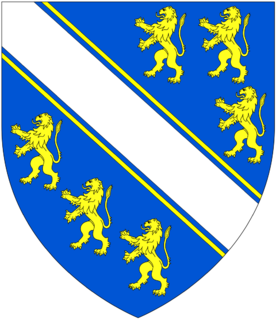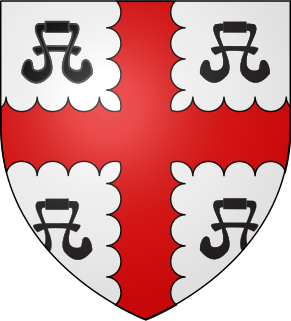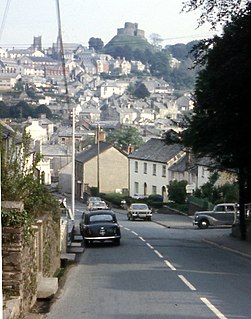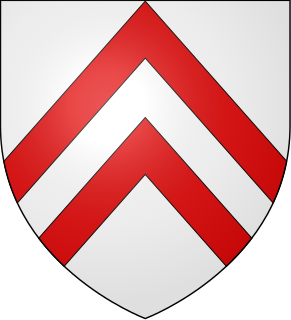Related Research Articles

Henry de Bohun, 1st Earl of Hereford of Pleshy Castle in Essex, was an Anglo-Norman nobleman who became Hereditary Constable of England from 1199.

Miles FitzWalter of Gloucester, 1st Earl of Hereford was a great magnate based in the west of England. He was hereditary Constable of England and Sheriff of Gloucestershire.

William de Redvers, 5th Earl of Devon, of Tiverton Castle and Plympton Castle, both in Devon, was feudal baron of Plympton in Devon.

William Bourchier, 1st Count of Eu, was an English knight created by King Henry V 1st Count of Eu, in Normandy.

John de Beauchamp, 2nd Baron Beauchamp of Somerset was an English peer and was feudal baron of Hatch in Somerset.
William I de Moyon, 1st feudal baron of Dunster in Somerset, was seigneur of Moyon in Normandy and became Sheriff of Somerset in 1086. He founded the English de Mohun family in the Westcountry. Recorded in the Domesday Book of 1086 as a tenant-in-chief of William the Conqueror holding a number of manors in Somerset with caput at Dunster Castle.
Humphrey III de Bohun of Trowbridge Castle in Wiltshire and of Caldicot Castle in south-east Wales, 5th feudal baron of Trowbridge, was an Anglo-Norman nobleman and general who served King Henry II as Lord High Constable of England.

Humphrey I de Bohun, of Trowbridge Castle in Wiltshire, jure uxoris 3rd feudal baron of Trowbridge, was an Anglo-Norman nobleman who by his lucrative marriage became "the founder of the fortunes of his family", later prominent in England as Earls of Hereford and Earls of Essex. He is usually enumerated "Humphrey I" even though following his father he was the second "Humphrey de Bohun" settled in England. He has even been called Humphrey the Great.
Edward of Salisbury was a nobleman and courtier (curialis), probably part Anglo-Saxon, who served as High Sheriff of Wiltshire during the reigns of William I, William II and Henry I.
William de Beauchamp was an Anglo-Norman baron and hereditary sheriff.
William de Courcy, feudal baron of Stoke Courcy in Somerset, was an Anglo-Norman nobleman.

Launceston was one of three Feudal baronies in Cornwall which existed in the mediaeval era. Its caput was at Launceston Castle.

The feudal barony of Plympton was a large feudal barony in the county of Devon, England, whose caput was Plympton Castle and manor, Plympton. It was one of eight feudal baronies in Devonshire which existed during the medieval era. It included the so-called Honour of Christchurch in Hampshire, which was not however technically a barony. The de Redvers family, first holders of the barony, were also Lords of the Isle of Wight, which lordship was not inherited by the Courtenays, as was the barony of Plympton, as it had been sold to the king by the last in the line Isabel de Redvers, 8th Countess of Devon (1237–1293).
The feudal barony of Curry Mallet was an English feudal barony with its caput at Curry Mallet Castle in Somerset, about 7 miles east of Taunton.

The feudal barony of Clifford was a feudal barony with its caput baroniae at Clifford Castle in Herefordshire, England.

Baron St Maur was a barony created by writ in 1314 for the soldier Nicholas de St Maur, of Rode in Somerset.
The feudal barony of Totnes was a large feudal barony with its caput at Totnes Castle in Devon, England. It was one of eight feudal baronies in Devonshire which existed in the mediaeval era. The first feudal baron was Juhel de Totnes, who is listed in the Domesday Book of 1086 as possessing 107 manors or other landholdings in Devon.
Manasser Biset was an Anglo-Norman nobleman and royal official during the reign of King Henry II of England. Biset was one of the most frequent witnesses on Henry's documents, and served the king as a justice and in financial matters. He was rewarded with lands in England which have led him to be considered the first feudal baron of Biset.
Ivo Pantulf was an Anglo-Norman nobleman and feudal baron of Wem in Shropshire.
Richard fitzUrse was an Anglo-Norman nobleman and feudal baron of Bulwick in Northamptonshire.
References
- ↑ Sanders, I.J. English Baronies: A Study of their Origin and Descent 1086-1327, Oxford, 1960, p.91
- ↑ Sanders, I.J. English Baronies: A Study of their Origin and Descent 1086-1327, Oxford, 1960, p.112
- ↑ Sanders, I.J. English Baronies: A Study of their Origin and Descent 1086-1327, Oxford, 1960, p.91
- ↑ Sanders, I.J. English Baronies: A Study of their Origin and Descent 1086-1327, Oxford, 1960, p.112
- ↑ G.E. Cokayne; with other editors, The Complete Peerage of England, Scotland, Ireland, Great Britain and the United Kingdom, Extant, Extinct or Dormant, new ed., 13 volumes in 14 (1910-1959; reprint in 6 volumes, Gloucester, U.K.: Alan Sutton Publishing, 2000), volume VI, page 457. Hereinafter cited as The Complete Peerage.
- Graeme White, "Bohun, Humphrey (III) de (b. before 1144, d. 1181)," Oxford Dictionary of National Biography , Oxford University Press, 2004, accessed 20 December 2009.